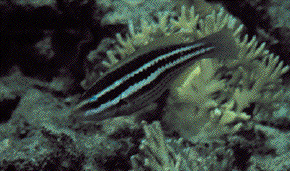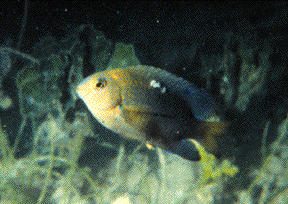|
The 'lab rat' of coral reef fish research:
Thalassoma bifasciatum |
Much of my research for the last decade has focused on herbivorous coral-reef fishes, particularly the Caribbean striped parrotfish, Scarus iserti. These relatively small, sex-changing, herbivores display a remarkably complex social organization (including group territories with dominance hierarchies, roving "satellite" individuals, and non-territorial schools that invade territories). Their range of mating tactics and alternative life-history strategies, coupled with their quantifiable food resources make them, in many ways, an ideal study organism. Additionally, the ability of these fish to respond quickly to changing environmental and demographic conditions makes them especially well-suited for both comparative and experimental field studies. By combining data on resource availability with experimental and comparative data on their behavior and demography my studies explore how physical and social environmental effects determine where animals are found and how they interact. |

 Scarus iserti
Scarus iserti Stegastes leucostictus
Stegastes leucostictus